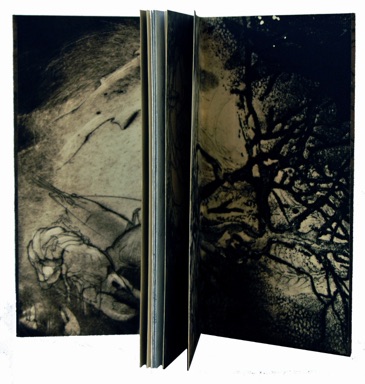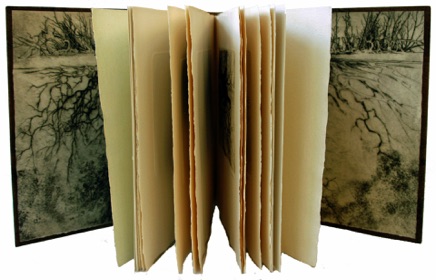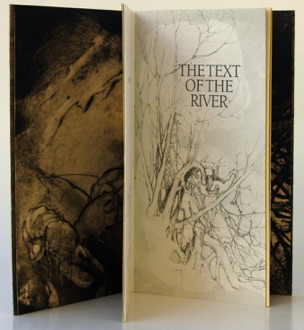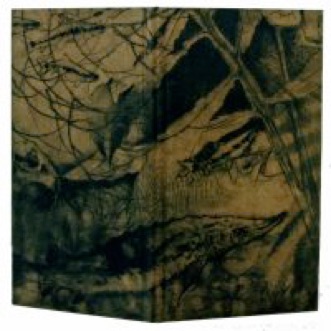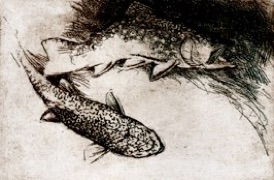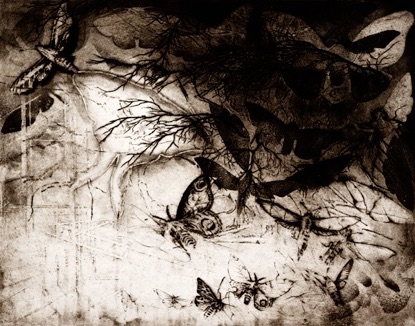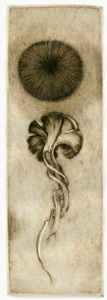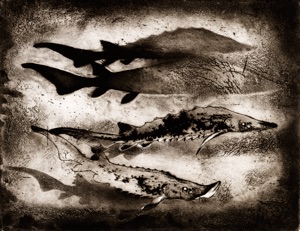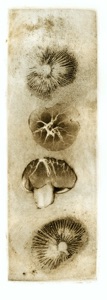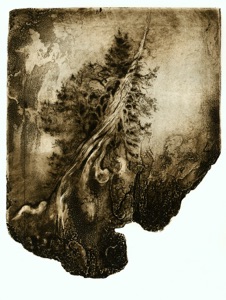I am an American of Czech parentage, and thus my interest in working with Jan Sobota and the Czech Society of Book Workers is a natural outgrowth of that bilingual family life. I studied in Austria, Germany and Czechoslovakia - as well as the US and earned masters degrees in both zoology and printmaking. I have been a free-lance artist since 1981, having had about 100 one-man shows and seen my work acquired by something over 80 public collections.
I came to the book arts from printmaking and illustration and see it as a natural progression for one with drawing skills and something to say. As an artist/naturalist, I have long admired the notebooks of Linnaeus, Audubon, Fuertes, DaVinci and the many other fine artist/naturalists that history has preserved for us. I value the trees, frogs and birds I portray in my etchings and find that I have observations on their ecology and natural history to communicate as well. Often times an interesting depiction or graphic innovation is simply not enough, when there is an underlying intellectual or experiential component that must be recorded alongside the sensual.
It doesn’t, however, end there. Difficult as it may be to describe, I know my work is ultimately a spiritual practice. I once heard Magdalena Abakanowiscz exhort an audience of fellow-artists with the closing question: “are we to be decorators, or Shamans? “ That hand across the generations from an elder has helped me frame the purpose of my own work, for the place of the artist has indeed become that of shaman, conjurer, trickster, story-teller - that of the person who finds uncommon information, with which to break the deadly mold of predictability, death and taxes and finds instead, another vision to deliver.
I have on occasion found myself contemplating an old tree, with sketchbook in hand and as I drifted off into reverie, became aware of a soul inhering in that wall of wood erupting from the earth before me. As my intellect becomes subdued and another means of perceiving becomes dominant, I perceive the tree before me expanding and contracting in measured pulses - like those of systole and diastole, taking place in a very slow , nearly imperceptible rhythm. In these moments I have been given a precious gift that I feel compelled to share. I do so as best I can, as I circle that very simple reality and point it out once from this angle and then from another perspective, closing in on truth with a combination of word and image.
All beings have spirit dwelling within them; all experience pain, joy, and mortality. As we open up and awaken, consciousness is clearly seen to be universal. I hear myself talking in generalities, communicating realizations that sound desperately banal in the telling, yet we knew all this as children and now it seems we must laboriously rediscover these relationships in later life - a second childhood - a second order innocence. It is embarrassing how simple things can be and how long we refuse to recognize this. Eternal verities become evident only gradually as one begins to appreciate the beauty, complexity and relationships inhering in all others and indeed all else - as one assumes a certain humility about what all remains unknown - perhaps even unknowable.
First double page from “Toads”
White Pine Cone: drypoint
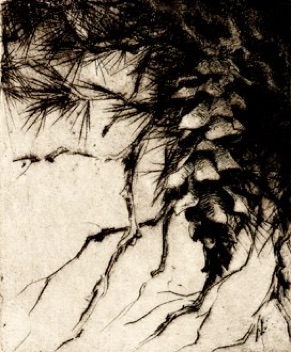
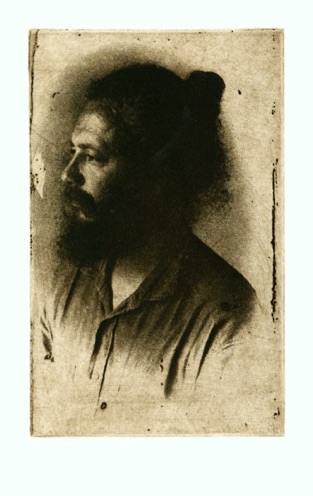
Portrait of Ladislav Haňka -
etching based on photo by
Luděk Vojtěchovsky
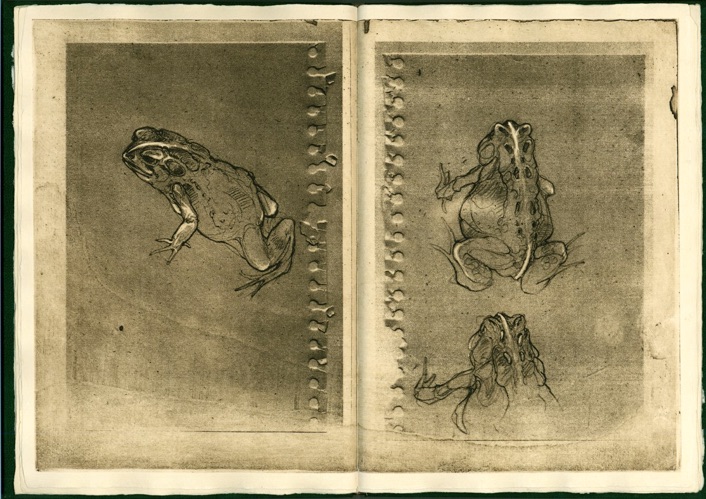
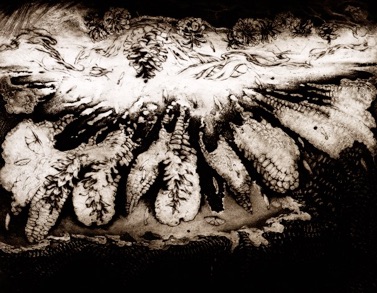
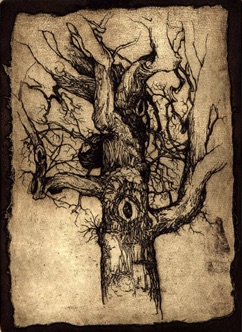
Million Dollar Oak: etching
This magnificent Bur Oak grows in a prairie opening of Southwest Michigan. I have occasionally stopped to admire and draw this tree and then heard that the owner of the land had been offered a million dollars by a sopping center developer, but that preferring the company of the big tree, he’d turned them down. We slip so easily into believing that there are no altruistic gestures or selfless people, but they live quietly among us - unobtrusively doing good . Bless them all.
How a Czech Book Spellbound Me
- Váchal gets his claws into me and never lets go
In 1979, I accepted an invitation to study privately with Jindra Schmidt, an engraver of stamps and currency in Prague – illegally I imagine, since any state takes the security of its currency seriously and I was the enemy - a cold-war emissary from the capitalist camp. I subsequently enrolled at the Hochschule für Angewandte Kunst in Vienna in1980 and traveled between Czechoslovakia and Austria frequently. On one of these trips I visited the National Museum’s rare book collection in Prague and discovered the book-works of Josef Váchal. The beauty of these idiosyncratic hand-made tomes with their rough inventive letterforms, unique to each book and hand-cast, generously interspersed with multi-colored woodcuts and bound in heavy full-leathers caught my imagination as books never had before. They leaned upon traditional Czech folklore with a maniacal inventiveness that I loved – full of diabolic bestiaries and gruesomely delicious skullduggery.
Demonic encyclopedias followed upon obscure astrological diaries and treatises on the spiritual life of a dog sniffing at fire hydrants. The plague was personified and followed on its rounds visiting the merchants and tradesmen on the Adriatic Isle of Korčula. It was positively liberating and I returned to Michigan with a project in mind. I went back with a typescript of folktales collected in the Czech-Moravian highlands by my own grandfather, Richard Neugebauer .I was determined to produce a Váchal-inspired hand-made imprint - to be entitled Čertův Kámen or Devil’s Rock. I later followed with a second volume entitled Pavlov and these then became the master-works capping off my formal art education.
“Reseeding the Fields” 1997
Etching with aquatint and drypoint
The displaced white pines, in whose remains our potatoes and oats are grown, live on in the soil and in myth – their progeny in adjacent forests continue to broadcast seed each year. These little packets of genetic potential lie ready to sprout and reclaim the land, whenever we allow it.

My Czech books are admittedly student work with all the shortcomings that implies – the youthful work of an idealist. It takes such youthful idealism to create as monumentally impractical a thing as a hand-made book of folk tales with black and white wood engravings printed in Czech for an American market. It was hardly a well-calculated business venture.
In my fervor to make a beautiful book, I went directly to the hand-made paper mill at Velké Losiny in northern Moravia. There under the shadow of the Jeseník Mountains near the southern Kladsko extension of Poland, I found the mill, on an old Baroque estate with massive oak beams reminiscent of Piranesi’s Carcieri (prison) etchings. The mill had burned down and was rebuilt in the 18th century in a style that was a bit new and vulgar for Czech tastes, but deliciously ancient to a young American. They were packed to the rafters and cellars with stacks of centuries-old paper and machinery of uncertain ages and use, gathering dust. I scored as much paper as could carry away.
Čertův Kámen and Pavlov are stories that have been filtered through generations of the collective unconscious and been found worthy of remembering and transmitting orally. They are the stories that children love and to which we later enjoy returning, connecting us to the wisdom of the ancestors. I find that the worth of story tellers and the enigmatic truths contained in myth become evident when I am at the end of my rope and the usual pragmatic solutions come up hollow. Deeply symbolic tales with multiple levels of meaning are what my soul needs when reason no longer suffices.
Storytellers are a priesthood in tune with subtler knowledge. As spiritual healers , they do their best work when they reach back into the most conservative traditions – reaching for their symbols into bags of tricks, words and images that have withstood the test of time - symbols that have the emotional power to evoke visions of life and death – dragons, horses, Gods, warriors, talking birds and princesses. This is why I draw skeletal fish returning by moonlight to the streams of their birth. This is why I fell in love with Váchal and this is why I produced Čertův Kámen.
Ladislav Haňka: photo by James Brode. I designed a lot of Beer Bottle Labels for the local Kalamazoo Brewery (Bell’s) over the course of 25 years. Here I am caught in Jim’s lense, sampling some of the fruits of that endeavor .

